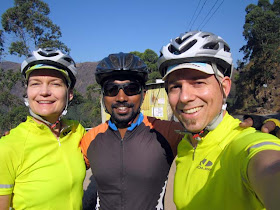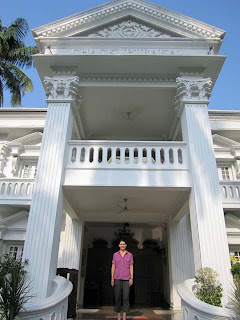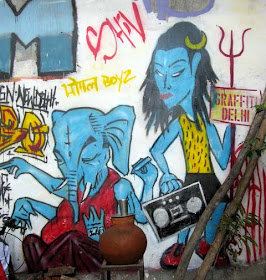We left lovely Fort Kochi so that we could start our bicycle tour of Kerala. This tour is a big splurge for us, and we are really excited to get to ride in this beautiful area. We are riding mountain bikes, with tires for the road conditions we will experience: slightly knobby to handle the potholes and loose gravel, but smooth enough to roll well on roads.

We stopped often to look at the types of plants that were being grown, and to enjoy the landscape. This is a picture of a rubber tree which has been tapped to collect the sticky, milky-looking latex.

The first night we stayed at Hornbill Camp on the Periyar river. The tents were first class!

It was incredibly peaceful and we heard lots of unusual birds. Here's a picture of Greater Cormorants.

We saw them while we were taking an evening paddle in a kayak.

We are dealing with the humidity and heat while we're riding by taking lots of breaks. Our favorite refreshing snack while we are riding is coconut water from the young, green coconuts. After we drink the water, the coconut is split in half so we can eat the coconut flesh inside, yum!


Kerala means "land of coconuts". In addition to coconut trees, there are also pineapples, bananas, and spices. This is cardamom. Even though the seeds were young, they still smelled deliciously like mature cardamom seeds - a key spice in chai and Indian cooking.


Here we are with our guide, Safi Hyder. He was a bike racing champion for Kerala. He says it's more fun to lead tours than it was to be a pro cyclist, and through his job he rides over 4,000 miles a year.

We get a lot of attention from the locals, who are interested in our funny clothes and high-end bikes. Here's a picture of a school - the kids were so excited to see us and wanted to be in our photo!

A great deal of tea is grown in Kerala and the plantations are incredibly beautiful, with the vibrant green leaves glowing in the sunshine. It is harvested every two weeks, which keeps the bushes well-manicured like topiary.

These women are having the tea they picked weighed, which will determine their earnings.

Kerala is filled with flowers. We recognize some because they also grow in the US, like bougainvillea and marmalade bushes and poinsettia and jacaranda trees. Here are some pretty trees (sorry, we don't know the names).



We stopped often to look at the types of plants that were being grown, and to enjoy the landscape. This is a picture of a rubber tree which has been tapped to collect the sticky, milky-looking latex.

The first night we stayed at Hornbill Camp on the Periyar river. The tents were first class!

It was incredibly peaceful and we heard lots of unusual birds. Here's a picture of Greater Cormorants.

We saw them while we were taking an evening paddle in a kayak.

We are dealing with the humidity and heat while we're riding by taking lots of breaks. Our favorite refreshing snack while we are riding is coconut water from the young, green coconuts. After we drink the water, the coconut is split in half so we can eat the coconut flesh inside, yum!


Kerala means "land of coconuts". In addition to coconut trees, there are also pineapples, bananas, and spices. This is cardamom. Even though the seeds were young, they still smelled deliciously like mature cardamom seeds - a key spice in chai and Indian cooking.


Here we are with our guide, Safi Hyder. He was a bike racing champion for Kerala. He says it's more fun to lead tours than it was to be a pro cyclist, and through his job he rides over 4,000 miles a year.

We get a lot of attention from the locals, who are interested in our funny clothes and high-end bikes. Here's a picture of a school - the kids were so excited to see us and wanted to be in our photo!

A great deal of tea is grown in Kerala and the plantations are incredibly beautiful, with the vibrant green leaves glowing in the sunshine. It is harvested every two weeks, which keeps the bushes well-manicured like topiary.

These women are having the tea they picked weighed, which will determine their earnings.

Kerala is filled with flowers. We recognize some because they also grow in the US, like bougainvillea and marmalade bushes and poinsettia and jacaranda trees. Here are some pretty trees (sorry, we don't know the names).




































